Related Research Articles
Finwë and Míriel are fictional characters from J. R. R. Tolkien's legendarium. Finwë is the first King of the Noldor Elves; he leads his people on the journey from Middle-earth to Valinor in the blessed realm of Aman. His first wife is Míriel, who, uniquely among immortal Elves, dies while giving birth to their only child Fëanor, creator of the Silmarils; her spirit later serves the godlike Vala queen Vairë. Finwë is the first person to be murdered in Valinor: he is killed by the Dark Lord Morgoth, who is intent on stealing the Silmarils. The event sets off the Flight of the Noldor from Valinor back to Beleriand in Middle-earth, and its disastrous consequences.
In J. R. R. Tolkien's fictional legendarium, Beleriand was a region in northwestern Middle-earth during the First Age. Events in Beleriand are described chiefly in his work The Silmarillion, which tells the story of the early ages of Middle-earth in a style similar to the epic hero tales of Nordic literature, with a pervasive sense of doom over the character's actions. Beleriand also appears in the works The Book of Lost Tales, The Children of Húrin, and in the epic poems of The Lays of Beleriand.
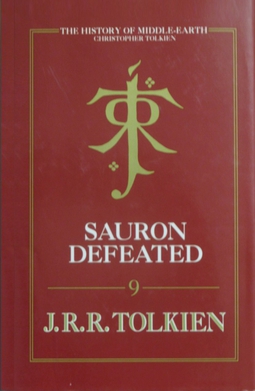
The History of Middle-earth is a 12-volume series of books published between 1983 and 1996 by George Allen & Unwin in the UK and by Houghton Mifflin in the US. They collect and analyse much of J. R. R. Tolkien's legendarium, compiled and edited by his son Christopher Tolkien. The series shows the development over time of Tolkien's conception of Middle-earth as a fictional place with its own peoples, languages, and history, from his earliest notions of "a mythology for England" through to the development of the stories that make up The Silmarillion and The Lord of the Rings. It is not a "history of Middle-earth" in the sense of being a chronicle of events in Middle-earth written from an in-universe perspective; it is instead an out-of-universe history of Tolkien's creative process. In 2000, the twelve volumes were republished in three limited edition omnibus volumes. Non-deluxe editions of the three volumes were published in 2002.

Morgoth's Ring (1993) is the tenth volume of Christopher Tolkien's 12-volume series The History of Middle-earth in which he analyses the unpublished manuscripts of his father J. R. R. Tolkien.
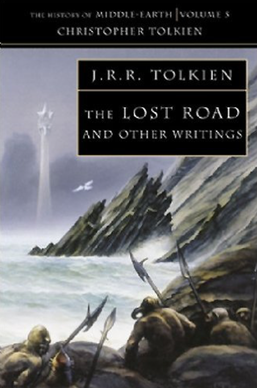
The Lost Road and Other Writings – Language and Legend before 'The Lord of the Rings' is the fifth volume, published in 1987, of The History of Middle-earth, a series of compilations of drafts and essays written by J. R. R. Tolkien in around 1936–1937. It was edited and published posthumously by his son Christopher.

The Atlas of Middle-earth by Karen Wynn Fonstad is an atlas of J. R. R. Tolkien's fictional realm of Middle-earth. It was published in 1981, following Tolkien's major works The Hobbit, The Lord of the Rings, and The Silmarillion. It provides many maps at different levels of detail, from whole lands to cities and individual buildings, and of major events like the Battle of the Pelennor Fields. The maps are grouped by period, namely the First, Second, and Third Ages of Middle-earth, with chapters on The Hobbit and The Lord of the Rings. A final chapter looks at geographic themes such as climate, vegetation, population, and languages around Middle-earth.
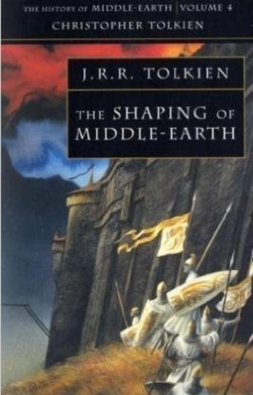
The Shaping of Middle-earth – The Quenta, The Ambarkanta and The Annals (1986) is the fourth volume of Christopher Tolkien's 12-volume series The History of Middle-earth in which he analysed the unpublished manuscripts of his father J. R. R. Tolkien.
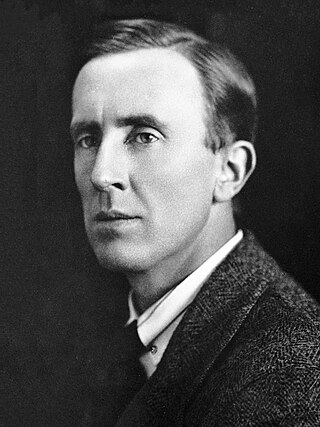
The Round World Version is an alternative creation myth to the version of J.R.R. Tolkien's legendarium as it appears in The Silmarillion and The Lord of the Rings. In that version, the Earth was created flat and was changed to round as a cataclysmic event during the Second Age in order to prevent direct access by Men to Valinor, home of the immortals. In the Round World Version, the Earth is created spherical from the beginning.
The works of J. R. R. Tolkien have generated a body of research covering many aspects of his fantasy writings. These encompass The Lord of the Rings and The Silmarillion, along with his legendarium that remained unpublished until after his death, and his constructed languages, especially the Elvish languages Quenya and Sindarin. Scholars from different disciplines have examined the linguistic and literary origins of Middle-earth, and have explored many aspects of his writings from Christianity to feminism and race.
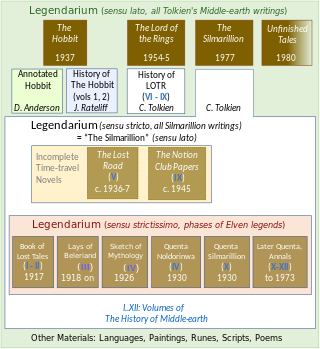
Tolkien's legendarium is the body of J. R. R. Tolkien's mythopoeic writing, unpublished in his lifetime, that forms the background to his The Lord of the Rings, and which his son Christopher summarized in his compilation of The Silmarillion and documented in his 12-volume series The History of Middle-earth. The legendarium's origins reach back to 1914, when Tolkien began writing poems and story sketches, drawing maps, and inventing languages and names as a private project to create a mythology for England. The earliest story, "The Voyage of Earendel, the Evening Star", is from 1914; he revised and rewrote the legendarium stories for most of his adult life.

Tolkien's Legendarium: Essays on The History of Middle-earth is a collection of scholarly essays edited by Verlyn Flieger and Carl F. Hostetter on the 12 volumes of The History of Middle-earth, relating to J. R. R. Tolkien's fiction and compiled and edited by his son, Christopher. It was published by Greenwood Press in 2000. That series comprises a substantial part of "Tolkien's legendarium", the body of Tolkien's mythopoeic writing that forms the background to his The Lord of the Rings and which Christopher Tolkien summarized in his construction of The Silmarillion.
Verlyn Flieger is an author, editor, and Professor Emerita in the Department of English at the University of Maryland at College Park, where she taught courses in comparative mythology, medieval literature, and the works of J. R. R. Tolkien. She is well known as a Tolkien scholar, especially for her books Splintered Light, A Question of Time, and Interrupted Music. She has won the Mythopoeic Scholarship Award four times for her work on Tolkien's Middle-earth writings.
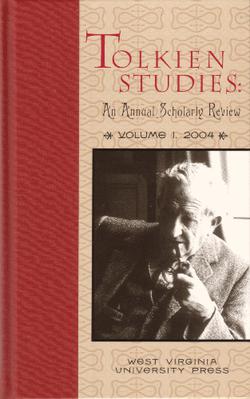
Tolkien Studies: An Annual Scholarly Review is an academic journal founded in 2004 publishing papers on the works of J. R. R. Tolkien. The journal's founding editors are Douglas A. Anderson, Michael D. C. Drout, and Verlyn Flieger, and the current editors are Michael D. C. Drout, Verlyn Flieger, and David Bratman. It states that it is the first scholarly journal published by an academic press in the area of Tolkien research.

The Silmarillion is a book consisting of a collection of myths and stories in varying styles by the English writer J. R. R. Tolkien. It was edited, partly written, and published posthumously by his son Christopher Tolkien in 1977, assisted by Guy Gavriel Kay, who became a fantasy author. It tells of Eä, a fictional universe that includes the Blessed Realm of Valinor, the ill-fated region of Beleriand, the island of Númenor, and the continent of Middle-earth, where Tolkien's most popular works—The Hobbit and The Lord of the Rings—are set. After the success of The Hobbit, Tolkien's publisher, Stanley Unwin, requested a sequel, and Tolkien offered a draft of the writings that would later become The Silmarillion. Unwin rejected this proposal, calling the draft obscure and "too Celtic", so Tolkien began working on a new story that eventually became The Lord of the Rings.

The music of Middle-earth consists of the music mentioned by J. R. R. Tolkien in his Middle-earth books, the music written by other artists to accompany performances of his work, whether individual songs or adaptations of his books for theatre, film, radio, and games, and music more generally inspired by his books.
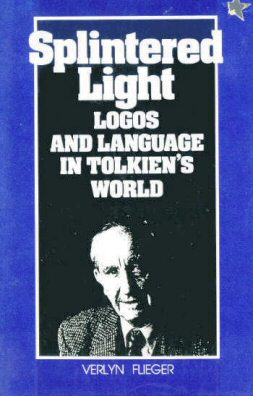
Splintered Light: Logos and Language in Tolkien's World is an 1983 book of literary criticism by the leading Tolkien scholar Verlyn Flieger, in which she argues that light is a central theme of Tolkien's Middle-earth mythology, in particular in The Silmarillion. It has been admired by other scholars to the extent that it has become a core element of Tolkien scholarship.

Tolkien's Art: 'A Mythology for England' is a 1979 book of Tolkien scholarship by Jane Chance, writing then as Jane Chance Nitzsche. The book looks in turn at Tolkien's essays "On Fairy-Stories" and "Beowulf: The Monsters and the Critics"; The Hobbit; the fairy-stories "Leaf by Niggle" and "Smith of Wootton Major"; the minor works "Lay of Autrou and Itroun", "The Homecoming of Beorhtnoth", "Imram", and Farmer Giles of Ham; The Lord of the Rings; and very briefly in the concluding section, The Silmarillion. In 2001, a second edition extended all the chapters but still treated The Silmarillion, that Tolkien worked on throughout his life, as a sort of coda.

The Old Straight Road, the Straight Road, the Lost Road, or the Lost Straight Road, is J. R. R. Tolkien's conception, in his fantasy world of Arda, of the route that his Elves are able to follow to reach the earthly paradise of Valinor, realm of the godlike Valar. The tale is mentioned in The Silmarillion and in The Lord of the Rings, and documented in The Lost Road and Other Writings. The Elves are immortal, but may grow weary of the world, and then sail across the Great Sea to reach Valinor. The men of Númenor are persuaded by Sauron, servant of the first Dark Lord Melkor, to attack Valinor to get the immortality they feel should be theirs. The Valar ask for help from the creator, Eru Ilúvatar. He destroys Númenor and its army, in the process reshaping Arda into a sphere, and separating it and its continent of Middle-earth from Valinor so that men can no longer reach it. But the Elves can still set sail from the shores of Middle-earth in ships, bound for Valinor: they sail into the Uttermost West, following the Old Straight Road.

A Question of Time: J.R.R. Tolkien's Road to Faërie is a 1997 book of literary analysis by Verlyn Flieger of J. R. R. Tolkien's explorations of the nature of time in his Middle-earth writings, interpreted in the light of J. W. Dunne's 1927 theory of time, and Dunne's view that dreams gave access to all dimensions of time. Tolkien read Dunne's book carefully and annotated his copy with his views of the theory. A Question of Time examines in particular Tolkien's two unfinished time-travel novels, The Lost Road and The Notion Club Papers, and the time-travel aspects of The Lord of the Rings. These encompass Frodo's dreams and the land of the Elves, Lothlórien.

Interrupted Music is a 2005 book of literary analysis by Verlyn Flieger of J. R. R. Tolkien's legendarium, the mass of documents summarized in The Silmarillion. Despite its title, it is not about Tolkien's use of music; it explores how and why he set about creating a mythology for England, what models he used as a guide – especially Elias Lönnrot and Arthurian legend, and how he made the mythology resemble a real one. The book has been well received by scholars; they have stated that the chapter on how Tolkien made the legendarium seem like a genuine tradition the most important in the book.
References
- ↑ Kozireski, Warren (13 January 2013). "Obituaries – Week of January 13, 2013". Westside News .
- 1 2 Whittingham 2008.
- ↑ Lee 2022, Note on Contributors.
- 1 2 3 Wolfe, B. N. (2010). "[Review:] The Evolution of Tolkien's Mythology: A Study of the History of Middle-earth. Critical Explorations in Science Fiction and Fantasy". The Chronicle of the Oxford University C.S. Lewis Society. 7 (1): 37–41. JSTOR 48617981.
- ↑ Lee 2022, "Unfinished Tales and The History of Middle-earth: A Lifetime of Imagination".
- ↑ Whittingham 2019.
- ↑ Rone 2022, pp. 113–141.
- ↑ Dawson 2008, pp. 205–209.
- 1 2 Bratman 2008, pp. 201–203.
